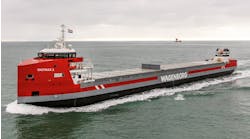William Furlow
Houston
- Geo Drilling has developed a containerized drilling system that can be delivered in 20-ft standard-size shipping containers for specialized drilling operations [23,354 bytes].
- The self-propelled Bima MPSV is equipped with a cantilevered derrick capable of working over a wide range of production platforms [29,002 bytes].
Containerized drilling introduced by Geo
A containerized drilling system (CDS) developed by Geo Drilling can be delivered in 20-ft standard-size shipping containers for specialized drilling operations. The unit is self-supported with the necessary electric and hydraulic power.The unit includes a heave compensated riser concept, heave compensated diamond drilling rig, and a mud mixing plant. It can be installed and mobilized within three days on any vessel with cargo capacity and open deck space for 5-10 cargo containers, and the capacity to carry an additional weight of 65-75 tons. The vessel also should be dynamically positioned. Once the CDS is set up, it can perform a variety of functions depending on the specific products purchased.
The unit can drill out continuous core samples of various diameters to a maximum combined water depth and hole depth of 1,500 meters. It is suited for geochemical core sampling and scientific drilling. The rig is also designed to drill shallow holes for the installation of sensors or measuring units on the sea floor.
Ursa utilizing new subsurface safety valve
Baker Oil Tools (BOT) has developed a new surface controlled subsurface safety valve system, the TM-11, for use on Shell Deepwater Development's Ursa tension-leg platform in the deepwater Gulf of Mexico. The TM-11 was designed to operate in deepwater, high-pressure/high temperature, corrosive, or hostile environment applications. The tool has a fail-safe setting depth of up to 8,000 ft, metal-to-metal sealing technology, a full open/closed control chamber, a permanent lock-open feature, and a curved flapper with a large alloy hinge pin to eliminate bending.Don Aldridge, Director for Cased Hole Completion Systems at BOT said Shell approached the company several years ago asking them to develop a safety valve for a TLP that would be installed in 4,000 ft of water. The challenge was to design a conventional heavy sprung safety valve with an 8,000 ft setting depth. Aldridge said the tool would be subjected to high working pressure, 11,000 psi, in a 5 1/2-in. tubular size. BOT started with its T series safety valve, added a spring package that would allow it to operate in a fail-safe mode at 8,000 ft, and used noble metallurgy (mostly nickel alloys) to ensure it could withstand the working pressure prescribed for this job.
While this product was specifically developed for Ursa, there may be applications on other fields in the future. Aldridge said BOT anticipates building a total of 11 TM-11 safety valves for Ursa. Shell agreed to pay for the development up front to assure delivery on short notice. Aldridge said all the prototype testing and API verification has been performed on the valve and the first unit should be delivered in the spring of 1999.
New grout diverter operated by ROV
Oil States has developed a new subsea grout diverter valve that can deliver grout to as many as eight pile sleeves. The diverter valve is designed to transport high volumes of grout or other viscous fluids. The inlet port of the valve can be fitted with the Oil States MCS female receptacle allowing a simple subsea connection. The nine outlet ports of the rotary selector valve are fitted with check valves to prevent back flow into the diverter valve.The valve can operate in up to 1,000 ft of water. A 2-in. grout hose is deployed into the water with a grout stinger on the end. The hose is picked up by a remotely operated vehicle (ROV), which stabs it into the diverter valve already installed on the platform or subsea manifold. Nitro gen or compressed air, pumped through an umbilical, inflates the stinger seals locking the stinger in place and isolating the packer injection ports. The face plate of the valve includes stabilization handles to help the ROV hold its position while dialing the grout selection valve.
The ROV can hold onto the handle with one arm and operate the selector valve with the other. Grout will then flow through the check valves into 2-in. piping or flexible grout hoses. These deliver the grout to the remote locations at up to 750 psi. As each section of the job is completed, the ROV will turn the selector valve and divert the grout to the next hose. The valve can handle up to eight grout lines and one flush line.
The design minimizes the weight of grout equipment, reduces ROV movement and the number of umbilicals deployed, and eliminates the need for fixed lines being run from the surface.
Sedco unveils Bima MPSV
The Bima is a purpose-built jackup designed by Sedco-Forex and MSC to perform a variety of workover and re-entry operations in water depths under 160 ft. The vessel is equipped with a full line of Schlumberger Oilfield Services intervention equipment. The vessel has a four-leg design, which eliminates the need for preloading, and is powered by two azimuthal thrusters, each with 21 tons of thrust, and a 17-ton tunnel thruster.The vessels features dual tubular handling systems on the deck, and an adjustable cantilever derrick. This design allows the rig to drill, run, and pull pipe on a variety of platforms with minimal rig-up time. The vessel is designed as a low-cost solution for production enhancement. It can perform all multipurpose service vessel operations including coiled tubing/workover operations, re-entry drilling, completion pulling/running services, underbalanced workover, and coiled tubing drilling, fluid and cement pumping, gravel packing, MWD, directional drilling, and logging and perforating.
Copyright 1998 Oil & Gas Journal. All Rights Reserved.


